Cozy Korean Sujebi Soup — Soft Dough, Clear Broth, and Love

Sujebi is a traditional Korean comfort soup made with hand-torn dough pieces simmered in a light anchovy and kelp broth. The chewy dough, soft vegetables, and gentle egg ribbons create a warm, homey flavour that feels like a taste of nostalgia.
This one-bowl meal is simple yet deeply satisfying ,made only with flour, water, and a few basic vegetables like potato, carrot, and zucchini. The dough is kneaded by hand, torn into thin pieces, and cooked directly in the broth.
A drizzle of beaten egg adds silkiness, while a side of soy dipping sauce, made with soy sauce, chili flakes, green onion, and sesame oil, that brings just the right touch of spice and depth.
It’s the kind of dish Korean families often make on rainy days, cosy, soothing, and full of handmade warmth.
🌾 The Story of Sujebi
Sujebi (수제비), sometimes spelled sujebee or hand-pulled dough soup, is one of Korea’s most humble and comforting traditional dishes. The word sujebi literally means “hand-folded” or “hand-torn” — su (hand) + jebi (to fold or tear).
Before rice became widely affordable, wheat flour was a precious ingredient in Korea. Families made sujebi as a way to stretch a small amount of flour into a filling, warm meal. It was especially common during times of hardship, such as after the Korean War, when people had to make do with simple ingredients.
Sujebi was often prepared by mothers and grandmothers on rainy days, when the sound of dough dropping into bubbling broth matched the soothing rhythm of rain. That’s why, even today, many Koreans say they crave a bowl of sujebi whenever it rains — it’s a dish that feels like a hug from home.
Each region in Korea has its own twist:
- Jeonju style sujebi uses anchovy broth with potatoes and kimchi.
- Gangwon Province often makes buckwheat sujebi, giving it a nuttier taste.
- In some homes, people make a spicy red sujebi with gochugaru (chili flakes), while others prefer a clear and mild broth.
What makes sujebi special is not luxury, but love. It’s a meal made by hand, for the people you care about, with whatever ingredients you have on hand. The soft, chewy dough and light broth remind many Koreans of warmth, simplicity, and family connection.
So, while sujebi might look like just flour, water, and broth, it carries generations of memory, resilience, and comfort in every bowl.
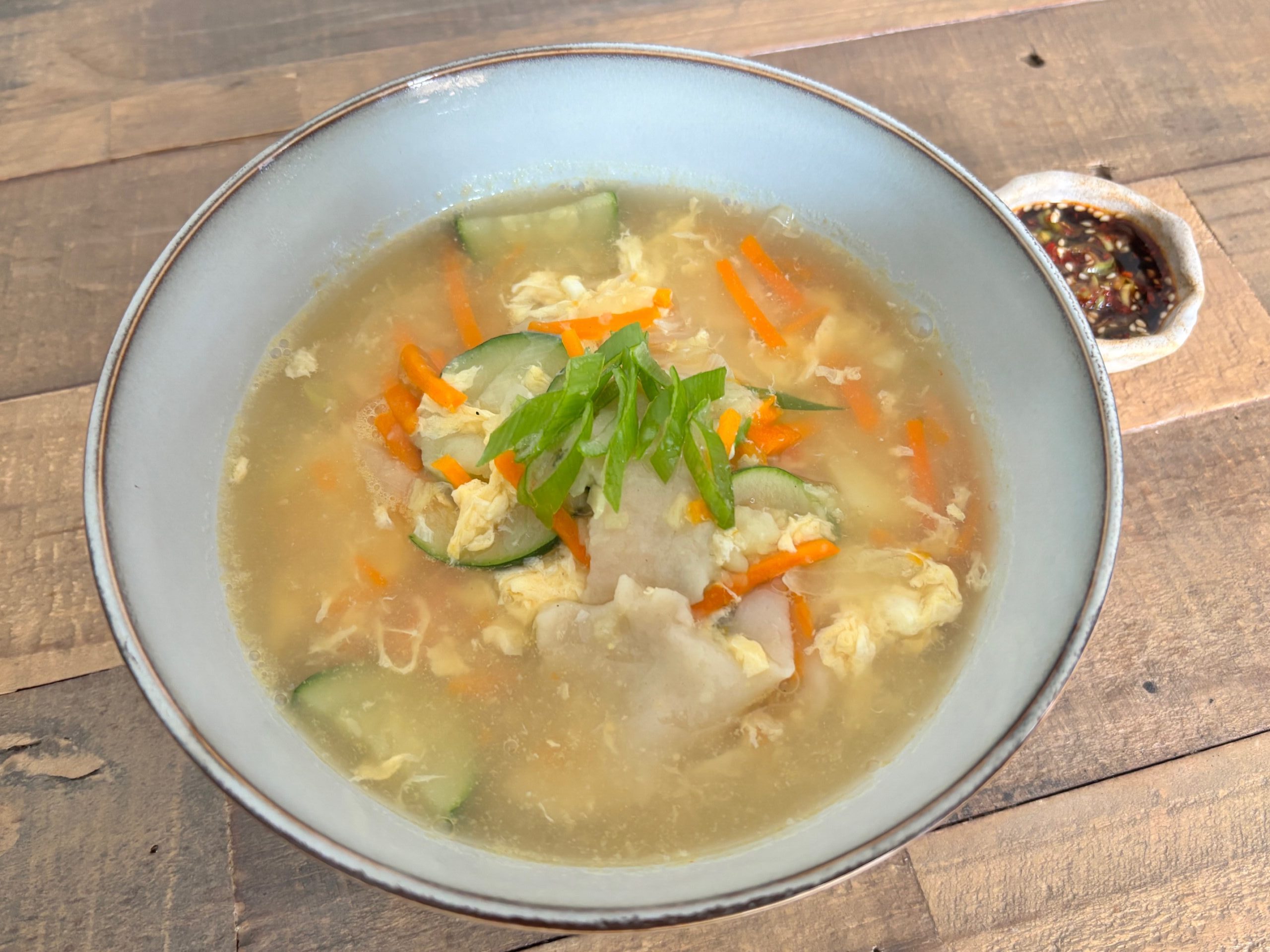
Handmade Korean Sujebi (Hand-pulled Dough Soup)
Ingredients
Method
- prepare ingredients
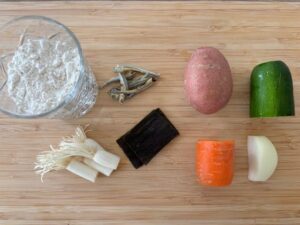
- Add water, anchovies, kelp, and the green onion root to a pot.

- Bring to a boil. Once it starts boiling, remove the kelp.
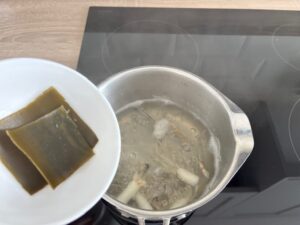
- Lower the heat and simmer for about 10 minutes.
- Strain to get a clear broth.
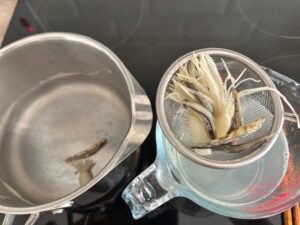
- Mix flour and salt in a bowl.
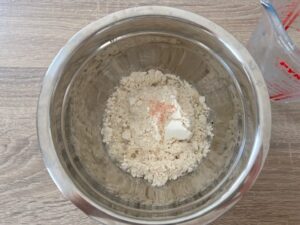
- Gradually add water while mixing until it forms a rough dough.

- Knead for about 5 minutes until smooth.

- Wrap in plastic wrap and let it rest in the fridge for 30 minutes.


- Potato: Peel and slice into thin half-moon shapes about 2–3 mm thick.

- courgette : Slice into thin half-moons shapes about 2–3 mm thick.
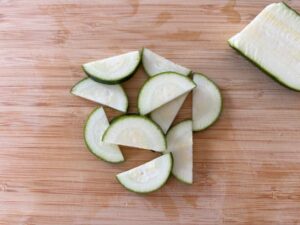
- Carrot: Peel and cut into thin julienne strips (matchstick size) — about 4 cm long and 2 mm thick
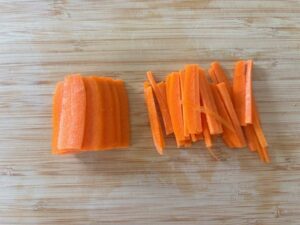
- onion : Slice into thin half about 2–3 mm thick.

- Green Onion (Spring Onion): Slice diagonally (bias-cut) into 1 cm pieces

- Bring your prepared broth to a boil.
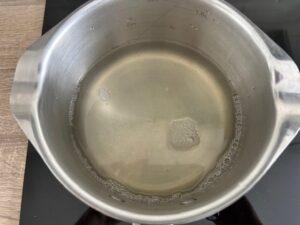
- Add potato, carrot and onion; boil for 3 minutes.

- Tear small, thin pieces of dough by hand and drop them into the boiling soup.
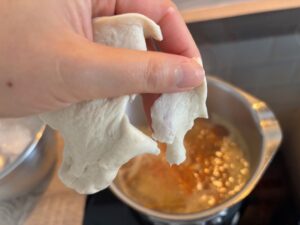
- Add courgette and green onion
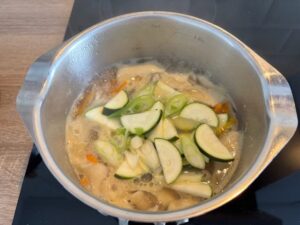
- When the dough pieces float and become slightly translucent, they’re cooked. (about 3-5mins)

- Beat 1 egg, then slowly drizzle it into the soup while gently stirring to create soft ribbons.

- Add season lightly with salt (1/2 tea spoon) or a bit of soy sauce (1/2 spoon).
- Serve with soy dipping sauce

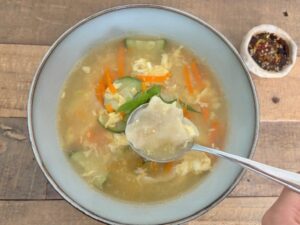
Notes
Sujebi Cooking Tips
1. Don’t skip dough resting time
Let the dough rest in the fridge for at least 30 minutes (up to 1 hour even longer).→ This allows the gluten to relax, making the dough chewier and easier to tear. If you skip this, it can turn tough or gummy.
2. Tear the dough thin and uneven — on purpose!
Sujebi is charming because every piece looks different.→ Tear each piece about 2–3 cm wide and paper-thin.
They’ll plump up when cooked, so thinner is better.
3. Add dough only when broth is boiling
Drop the pieces into rolling boiling broth — this helps them cook fast and stay separate instead of sticking together.4. Add vegetables in the right order
Start with the harder ones first (potato, carrot), then add softer ones (zucchini, green onion) later so nothing turns mushy.5. Drizzle egg slowly
When adding beaten egg, pour it in a thin stream and wait 10–15 seconds before stirring.→ This creates soft, ribbon-like egg strands, not scrambled chunks.
6. Season lightly, then adjust at the table
Sujebi broth is meant to taste gentle and clean.→ Keep the soup lightly seasoned, and let the soy dipping sauce add extra saltiness or spice when you eat.
7. Enjoy it fresh!
Sujebi dough absorbs broth quickly.→ It’s best eaten right after cooking — the texture is perfect when it’s hot and freshly made. 8. Enjoy with fresh Kimchi if you have one.
